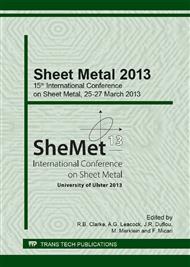p.463
p.471
p.477
p.484
p.492
p.503
p.511
p.521
p.529
Friction Stir Welding of Tailored Blanks of Aluminum and Magnesium Alloys
Abstract:
The following paper describes a feasibility study of butt joining friction stir welding between aluminum alloy AA6016 and magnesium alloys AZ91 and AM50. Because of the variety of inimitable properties according to lightweight design and constructions, the interest in aluminum and magnesium alloys is increasing in many fields of industry. Due to the low solubility of aluminum in magnesium and inverse, these alloys tend to the formation of intermetallic phases during the joining process. This leads to an increasing micro hardness within the seam, which should be avoided. By the use of joining methods with low process temperatures, the formation of intermetallic phases is reduced. According to this circumstance, friction stir welding is an excellent alternative to fusion welding techniques used to join this alloys. The main welding process variables were exposed in the studies of similar butt joints of Al/Al and Mg/Mg. These were examined in connection to their transferability to the dissimilar joints and tailored blanks. Furthermore, the influence of different tool geometry on seam quality was investigated. The effect of process variables (mainly welding speed and revolution speed) were correlated to the results of tensile strength test. The welded samples were assayed in the presence of intermetallic phases.
Info:
Periodical:
Pages:
492-499
Citation:
Online since:
April 2013
Authors:
Price:
Сopyright:
© 2013 Trans Tech Publications Ltd. All Rights Reserved
Share:
Citation:


